
Wendell M. Stanley was awarded the 1946 Nobel Prize in Chemistry with John Howard Northrop and James Batcheller Sumner. One-half of the prize was awarded to Sumner for “his discovery that enzymes can be crystallized,” and the other half was awarded jointly to Northrop and Stanley for “their preparation of enzymes and virus proteins in a pure form.” By isolating and crystallizing tobacco mosaic virus (TMV), Stanley demonstrated that viruses blurred the lines between the living organisms studied by biologists and the nonliving molecules studied by chemists.
Trained as a chemist, Stanley approached TMV from a different perspective than that of the microbiologists. He brought a new set of biochemical techniques for crystallization, recently developed by Sumner and modified by Northrop, to the field of virology. Stanley and Northrop were colleagues at the Department of Plant and Animal Pathology, an extension of the Rockefeller Institute for Medical Research in Princeton. With Northrop’s encouragement and support, Stanley modeled his TMV work on Northrop’s studies of enzymes. Having crystallized the enzyme pepsin in 1929, Northrop demonstrated the following year that it was a pure protein. Five years later, Stanley crystallized TMV and suggested that it, too, was a pure protein. By 1937, however, he recognized that TMV crystals were actually nucleoproteins. Furthermore, Stanley demonstrated that these nucleoproteins, apparently lifeless in crystallized form, sprang back to life and multiplied when dissolved and reintroduced into tobacco. This was a revolutionary discovery, for it challenged the widely held belief that diseases were transmitted only by living organisms.
Picture Credit : Google




